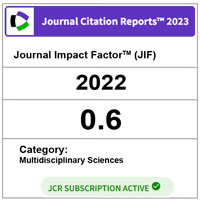Effect of Stretching Rate on Tensile Response and Crystallization Behavior of Crosslinked Natural Rubber
DOI:
https://doi.org/10.11113/mjfas.v17n3.2039Keywords:
Deformation Rate, Tensile Response, Crystallization, Natural RubberAbstract
The performance of natural rubber (NR) relies heavily on the microstructural changes during deformation. This has brought to significant change in the stress response of NR. Besides, the stretching rate may also affect the stress response of NR. In this study, effects of stretching rate on tensile deformation and strain-induced crystallization of crosslinked NR were investigated. Results indicated that increasing the strain rate has increased the stress at given strain where the onset of strain-induced crystallization was shifted to a lower strain. The crystallinity of the crosslinked NR was shown to be higher at a high stretching rate and it corresponded well with the tensile response. The results clearly confirm that chain orientation and crystallization became stronger with increasing deformation rate. The study also suggests that the deformation could improve distribution of crosslinked network structures.References
M. L. Dannis, “Stress-strain testing of rubber at high rates of elongation,” Rubber Chemistry and Technology, vol. 36, no. 1, pp. 28-49, 1963.
M. S. H. Fatt and I. Bekar, “High-speed testing and material modeling of unfilled styrene butadiene vulcanizates at impact rates,” Journal of Materials Science, vol. 39, no. - , pp. 6885-6899. 2004.
C. M. Roland, “Mechanical behavior of rubber at high strain rates,” Rubber Chemistry and Technology, vol. 79, no. 3, pp. 429-459, 2006.
B. Song and W. Chen, “One-dimensional dynamic compressive behavior of EPDM rubber,” Journal of Engineering Materials and Technology, vol. 125, no. 3, pp. 294-301, 2003.
O. A. Shergold, N. A. Fleck and D. Radford, “The uniaxial stress versus strain response of pig skin and silicone rubber at low and high strain rates,” International Journal of Impact Engineering, vol. 32, no. 9, pp. 1384-1402, 2006.
L. Mullins, “Effect of stretching on the properties of rubber,” Rubber Chemistry and Technology, vol. 21, no. 2, pp. 281-300, 1948.
P. H. Mott, J. N. Twigg, D. F. Roland, H. S. Schrader, J. A. Pathak and C. M. Roland, “High-speed tensile test instrument,” Review of Scientific Instruments, vol. 78, no. 4, Article ID 045105, 2007.
M. Hussein, “Effects of strain rate and temperature on the mechanical behavior of carbon black reinforced elastomers based on butyl rubber and high molecular weight polyethylene,” Results in Physics, vol. 9, no. -, pp. 511-517, 2018.
M. Cheng and W. Chen, “Experimental investigation of the stress–stretch behavior of EPDM rubber with loading rate effects,” International Journal of Solids and Structures, vol. 40, no. 18, pp. 4749-4768, 2003.
Y. Miyamoto, H. Yamao and K. Sekimoto, “Crystallization and melting of polyisoprene rubber under uniaxial deformation,” Macromolecules, vol. 36, no. 17, pp. 6462-6471, 2003.
N. Candau, R. Laghmach, L. Chazeau, J. M. Chenal, C. Gauthier, T. Biben and E. Munch. “Influence of strain rate and temperature on the onset of strain induced crystallization in natural rubber,” European Polymer Journal, vol. 64, no. -, pp. 244-252, 2015.
M. Tosaka, S. Murakami, S. Poompradub, S. Kohjiya, Y. Ikeda, S. Toki, I. Sics and B. S. Hsiao, “Orientation and crystallization of natural rubber network as revealed by WAXD using synchrotron radiation,” Macromolecules, vol. 37, no. 9, pp. 3299-3309, 2004.
Y. Ikeda, Y. Yasuda, K. Hijikata, M. Tosaka and S. Kohjiya, “Comparative study on strain-induced crystallization behavior of peroxide cross-linked and sulfur cross-linked natural rubber,” Macromolecules, vol. 41, no. 15, 5876-5884, 2008.
X. Chen, X. X. Li and U. R. Cho, “Preparation of hydroxyethyl cellulose-bamboo charcoal (HxBy) hybrid and its application to reinforcement of natural rubber,” Polymer (Korea), vol. 43, no. 3, pp. 351-358, 2019.
J. Richeton, S. Ahzi, L. Daridon and Y. Rémond, “A formulation of the cooperative model for the yield stress of amorphous polymers for a wide range of strain rates and temperatures,” Polymer, vol. 46, no. 16, pp. 6035-6043, 2005.
D. Rana, V. Sauvant and J. L. Halary, “Molecular analysis of yielding in pure and antiplasticized epoxy-amine thermosets,” Journal of Materials Science, vol. 37, no. -, pp. 5267-5274, 2002.
A. Masa, S. Iimori, R. Saito, H. Saito, T. Sakai, A. Kaesaman and N. Lopattananon, “Strain-induced crystallization behavior of phenolic resin crosslinked natural rubber/clay nanocomposites,” Journal of Applied Polymer Science, vol. 132, no. 39, Article ID 42580, 2015.
A. Masa, R. Saito, H. Saito, T. Sakai, A. Kaesaman and N. Lopattananon, “Phenolic resin-crosslinked natural rubber/clay nanocomposites: Influence of clay loading and interfacial adhesion on strain-induced crystallization behavior,” Journal of Applied Polymer Science, vol. 133, no. 12, Article ID 43214, 2016.
S. Toki, I. Sics, S. Ran, L. Liu and B. S. Hsiao, “New insights into structural development in natural rubber during uniaxial deformation by in situ synchrotron X-ray diffraction,” Macromolecules, vol. 35, no. 17, pp. 6578-6584, 2002.
M. Tosaka, S. Kohjiya, Y. Ikeda, S. Toki and B. S. Hsiao, “Molecular orientation and stress relaxation during strain-induced crystallization of vulcanized natural rubber,” Polymer Journal, vol. 42, no. -, pp. 474-481, 2010.
H. P. Klug and L. E. Alexander, “X-ray diffraction procedures: For polycrystalline and amorphous materials,” Wiley, New York, 1974.
G. Weng, G. Huang, H. Lei, L. Qu, Y. Nie and J. Wu, “Crack initiation and evolution in vulcanized natural rubber under high temperature fatigue integrated intensity,” Polymer Degradation and Stability, vol. 96, no. 12, pp. 2221-2228, 2011.
N. Osaka, M. Kato and H. Saito, “Mechanical properties and network structure of phenol resin crosslinked hydrogenated acrylonitrile‐butadiene rubber,” Journal of Applied Polymer Science, vol. 129, no. 6, pp. 3396-3403, 2013.







